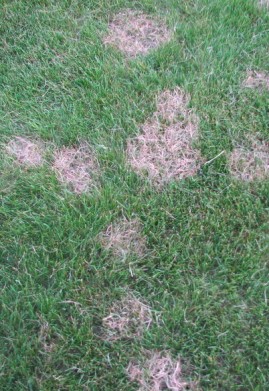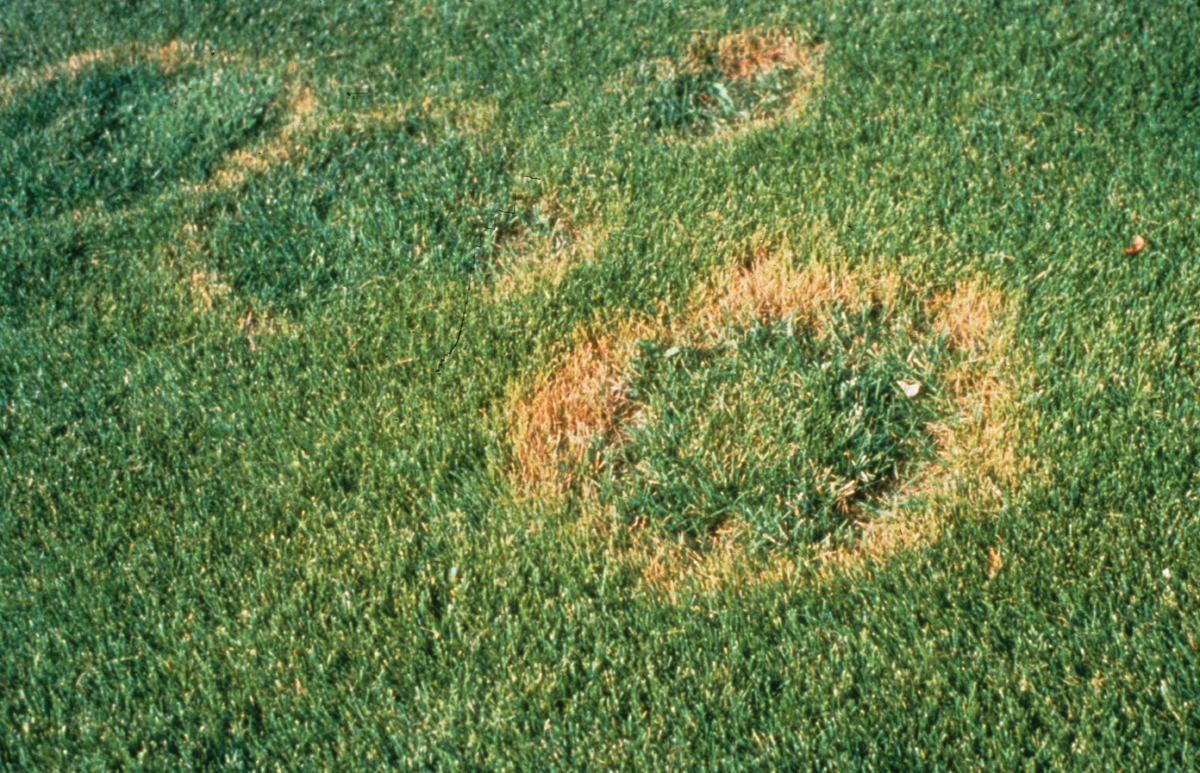Snow Mold
Pink Snow Mold
Gray Snow Mold
Both Pink Snow Mold and Gray Snow Mold occur in temperatures just above freezing and in moist conditions. These conditions occur most frequently under snow cover or anything that covers the lawn, such as fallen tree leaves.
Both fungi will appear as circular patches (3"- 12" or more). It’s pretty easy to tell the two apart: one has pink coloration and the other a grayish matting. Closer examination of the gray patches will reveal tiny black dots (mycelial masses) on the blades. The pink species may resemble another common disease, red thread, but occurs much earlier in the season.
Both are unsightly, but gray snow mold does not usually cause permanent damage. Pink snow mold may cause damage, particularly in the middle of the spots. However, rapid spring growth will often cause those spots to fill in on their own.
Conditions that favor the disease are excessive flush growth before the onset of winter, piles of leaves that remain on the lawn area through the winter, and/or an early snowfall. It is important to time fall fertilization so that excessive top growth is not spurred on before snowfall, and any late fall fertilization is done after top growth ceases.
Preventive applications of fungus controls, just prior to winter, are effective on lawns that have a history of severe infestations. Bear in mind that fungus control applications are not a complete cure. They simply control it through the winter.
What you can do:
Clean leaves off, or mulch them into the lawn before winter so that there are no accumulations through the dormant season.
Avoid piling too much snow on areas that have a history of problems.
If snow mold is present after snow melt, wait until the lawn dries a bit and lightly fluff up matted areas, with a leaf rake, to help air circulate and dry it out. Most snow mold will recover completely once the rapid growth starts unless it is a very serious case.
Brown Patch
Brown Patch fungus is a serious summer disease. It is occurs during periods of high heat and humidity.
On closely mowed turf, such as golf course greens, the circular pattern is very well defined. On higher mowed turf, such as residential lawns, the pattern may be a bit less circular. The leaf blades will have irregularly shaped purplish-brown lesions. In the early morning, when the dew is still on the grass, there may be gray, web-like mycelia around the outer edges of the circles, giving it a “smoke-ring” appearance. This usually disappears as soon as the dew dries out.
Conditions that favor the disease are hot and humid. Days in the 90s and nights in the high 60s are perfect for brown patch development. This disease can spring up rapidly and what was green, healthy looking turf the day before can have well-developed patches the next day.
Excessive irrigation is a culprit in increased disease severity. Daily watering will usually cause greater disease problems.
Excessive water-soluble nitrogen applications, before hot weather, can create succulent growth which will be very susceptible to this disease.
We can apply fungus controls for more serious cases. Bear in mind that fungus control applications are not a complete cure. They simply control it for a period of about 1 month.
Dollar Spot
Dollar Spot fungus is a foliar disease, which means that it attacks only the blades of grass. On higher mowed turf, it doesn’t affect the most important parts of the plant, which are the crown and roots, unless the disease increases in severity. This makes it a serious problem if the disease persists for several weeks and conditions do not favor recovery.
It is common since it is spread by spores from lawnmowers, though the air, and anything else that it comes in contact with. Also, since it attacks the upper foliage, it becomes noticeable as soon as it attacks the plant. It occurs during periods of prolonged moisture, and humidity, when temperatures are in the 70s and 80s, (typically summer). It may resemble another common disease, red thread, and is often found mixed in among red thread infested turf. However, instead of pink threads, there will be tan hour-glass shaped lesions, with dark borders, on the grass blades and dead foliage will have a bleached appearance. Even when the fungus ceases to be active, the lawn may be slow to rid itself of the bleached out leaves since summer growth is usually pretty slow.
Conditions that favor the disease are warm, and humid. Excessive irrigation is a culprit in increased disease severity. Daily watering will usually cause greater disease problems.
An application of nitrogen can help mitigate the disease, but there’s no guarantee that it will clear it completely. It’s important to note that applying nitrogen to combat this problem, in excess of the normal service applications, can increase the chances of having more serious disease problems besides dollar spot.
We can apply fungus controls for more serious cases. Bear in mind that fungus control applications are not a complete cure. They simply control it for a period of about 1 month.
Leaf Spot/Melting Out
Leaf spot/melting out are actually two different fungi, which attack the lawn at different times of the year. Both can be serious problems, especially as the diseases progress. It’s important to note that virtually every lawn has a little bit of leaf spot fungus and just seeing a few spots is generally no cause for alarm. It’s presence, however, should be taken as a warning to be sure proper cultural practices, such as mowing and watering, are adhered to as much as possible to prevent further development.
The two most common fungi in this family both exhibit the same symptoms at initial infection: Purplish colored lesions that develop tan centers as they expand. In severe cases, these lesions can expand to the entire leaf, giving it a wet, brown, and wilted appearance. It is common since it is spread by spores from lawnmowers, though the air, and anything else that it comes in contact with. One fungus attacks more in the spring during periods of heavy rain and humidity. The other tends to occur when temperatures are in the 80s and 90s, (typically summer). The summer fungus has more of a tendency to cause the “melting out,” or complete discoloration and wilt all the way down to the crown and roots. This is the most damaging stage. Prolonged melting out will usually result in permanent damage, or a very long period of recovery.
Conditions that favor the disease are humid, rainy weather. Excessive irrigation is a culprit in increased disease severity. Daily watering will usually cause greater disease problems.
Excessive nitrogen will only feed the diseases, so proper lawn feeding is essential for managing these fungi.
We can apply fungus controls for more serious cases. Bear in mind that fungus control applications are not a complete cure. They simply control it for a period of about 1 month.
Pythium Blight
Pythium damping off is a disease that attacks new seedlings. Infected grass either fails to germinate or the seedlings become discolored, topple over, and die.
Pythium blight, on mature lawns, begins as small, slimy, or greasy spots. The disease is often referred to as “greasy spot” or “cottony blight.”
Symptoms of either fungus can best be observed in the early morning or when the lawn is wet, when greasy spots may be surrounded by white webs, resembling tufts of cotton candy. These white webs will usually disappear as soon as the lawn dries out, but the grease spots remain.
Conditions that favor the disease are hot, humid, and poorly drained sites. Other areas of excessive shade that may remain moist, are susceptible.
Excessive irrigation is a culprit in increased disease severity. Daily watering, such as the watering regimen required for seedling germination, will usually cause greater disease problems. So will excessive nitrogen applications.
What you can do:
Water per our instructions.
Take note of where water may be pooling after regular watering.
Prune out lower branches in areas where turf is thin to allow more sunlight and air circulation.
We can apply fungus controls for more serious cases. Bear in mind that fungus control applications are not a complete cure. They simply control it for a period of about 1 month.
Red Thread Fungus
Red thread fungus is the most common disease that we encounter. It attacks the upper blades of grass. It first appears as pinkish spots, usually 3-6” in diameter in sunny areas of the lawn. It may then progress to sprout string-like red hyphae, or “threads.” Severe cases may result in the circles coalescing to create one big patch. The good news is that it does not affect the most important parts of the plant, which are the crown and roots. This makes it the least damaging to the lawn, in the long run, but it can become very unsightly. The affected areas will turn brown as the weather warms and the disease goes dormant. It can take a long time for these spots to grow out and disappear.
Fine fescues are most susceptible, followed by perennial ryegrass, then Kentucky bluegrass. Bentgrasses are usually not affected.
Since it attacks the upper grass blades, it becomes noticeable quickly. It usually shows up during periods of prolonged moisture, when temperatures are in the 60’s and 70’s, (typically late May-June) and the first flush of spring growth slows down. Conditions that favor the disease are warm, humid, and rainy. Watering too often will make it worse.
An application of nitrogen can help, but there’s no guarantee that it will clear it completely. As a matter of fact, it can increase the chances of having more serious disease problems besides red thread. We can apply fungus controls, but they are costly and just control it for a period of time.
What you can do:
Water as we instruct you to. We leave instructions at each service. This disease is greatly influenced by how often the lawn is watered. Reach out to us if you're unsure.
If the disease is severe, pick up grass clippings.
In severe cases, a spray of 10% bleach solution on mower wheels, deck, and blades will help control the spread.
We can apply fungus controls for more serious cases, though they’re not a complete cure. They simply control it for a period of about 1 month.
Summer Patch
Necrotic Ring Spot
Summer Patch
Necrotic Ring Spot and Summer Patch are two different fungi with essentially identical symptoms. The difference is the time of season that they are active. These are both common and serious diseases of Kentucky bluegrass sod that are about 2–4 years old. They affect the roots of the grass. They do not attack bentgrass nor ryegrass.
Necrotic Ring Spot (NRS) is active during the spring and fall in wet weather. Summer patch is active in hotter weather.
Initial symptoms are rings of wilting turfgrass, which develop during the heat of the day. These will often go unnoticed until the wilted rings turn brown, creating “frog eye” patterns scattered throughout the infected area. Since the roots are what are typically attacked, there are no apparent lesions on the leaves.
These diseases are so common in bluegrass sod that we’ll often implement a fungus control program before the disease is even apparent.
Avoid excessive application of water-soluble forms of nitrogen before periods of high heat. As they are in managing all diseases, proper mowing and watering are important.
We can apply fungus controls for more serious cases. Bear in mind that fungus control applications are not a complete cure. They simply control it for a period of about 1 month.
For more information regarding diseases that may be effecting your lawn health, please do not hesitate to give us a call, or shoot us an email.
















